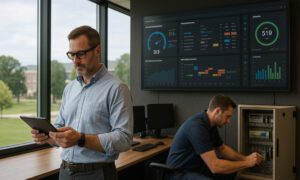The image of a coworking space has evolved far beyond just open-plan offices and free coffee. Today, it represents a dynamic, connected, and seamless ecosystem where freelancers, remote workers, and enterprises converge to innovate and collaborate. The invisible force powering this evolution is technology for coworking space. No longer a mere convenience, this integrated tech stack is the essential digital backbone that transforms physical real estate into a thriving, efficient, and scalable community.
This article delves into the critical technologies that define the modern coworking experience, exploring how they benefit both operators and members alike.
The Core Pillars of Coworking Technology
The ecosystem of coworking technology can be broken down into several key pillars, each addressing a fundamental operational or experiential need.
1. Membership and Access Management: The Digital Gatekeeper
The foundation of any secure space is controlled access. Modern systems have moved far beyond simple key fobs.
- Keyless Entry: Mobile apps allow members to use their smartphones as digital keys, granting them 24/7 access based on their membership tier.
- Automated Onboarding: When a new member signs up, the software can automatically generate access credentials, send welcome emails, and set up their billing—all without manual intervention from staff.
- Enhanced Security: Operators can monitor access in real-time, deactivate credentials instantly, and manage permissions for different zones (e.g., private offices, meeting rooms, phone booths).
2. Space Management and Booking Software: Optimizing Utilization
This is the brain of the operation. Desk and room booking software provides a live view of space availability.
- Hot-Desking Made Easy: Members can see which desks are available and book them via an app before they even arrive, eliminating the morning “desk hunt.”
- Meeting Room Monetization: Spaces can efficiently book and bill for meeting rooms, conference areas, and event spaces. Integrated displays outside rooms show real-time booking status, preventing awkward interruptions.
- Data-Driven Decisions: Operators gain invaluable insights into space usage patterns. This data helps them understand which areas are underutilized and which are in high demand, informing future space design and expansion.
3. Billing and Invoicing Automation: Financial Efficiency
Manual invoicing for hundreds of members with different plans and add-ons is a nightmare. Automated billing software eliminates this pain point.
- Recurring Invoicing: The system automatically generates and sends invoices for monthly memberships.
- Flexible Billing: It easily handles one-time charges for room bookings, day passes, printing services, or coffee bar purchases.
- Payment Integration: Seamless integration with payment gateways like Stripe or PayPal ensures secure and timely transactions, improving cash flow and reducing administrative overhead.
4. Community Engagement Platforms: Fostering Connection
The true value of a coworking space lies in its community. Technology bridges the gap between physical presence and digital interaction.
- Member Directories and Apps: Private social networks or apps allow members to create profiles, list their skills, and connect with others for collaboration.
- Event Management: Operators can promote upcoming workshops, networking events, and socials directly through the platform, managing RSVPs and attendance.
- Announcements and Newsletters: Targeted announcements can be pushed to all members or specific groups, keeping everyone informed and engaged.
Emerging Tech Trends Shaping the Future
The technological landscape is constantly evolving, bringing new innovations to the forefront.
- Internet of Things (IoT): Smart sensors can control lighting and temperature based on occupancy, reducing energy costs. They can also monitor meeting room usage automatically, ensuring accurate billing.
- Data Analytics and Business Intelligence: Advanced analytics platforms crunch data from all other systems (bookings, access, billing) to provide a holistic view of business performance, predict trends, and offer actionable insights.
- Smart Building Integration: Technology for coworking spaces is increasingly integrating with the building’s own systems for a seamless experience, from booking parking spots to managing elevator access.
The Tangible Benefits of Integrating Technology
Investing in a robust tech stack delivers clear returns for both operators and members.
For Operators:
- Operational Efficiency: Automates repetitive tasks, freeing up staff to focus on community building and member success.
- Scalability: Makes it significantly easier to manage one location or twenty without a proportional increase in administrative staff.
- New Revenue Streams: Enables the monetization of previously underutilized assets like meeting rooms or day passes.
- Data-Driven Growth: Provides the insights needed to make smart business decisions.
For Members:
- Seamless Experience: Offers a frictionless, professional experience from booking to billing.
- Flexibility and Autonomy: Empowers members to manage their workspace on their own terms, 24/7.
- Enhanced Networking: Provides tools to easily connect and collaborate with other professionals in the community.
- Professional Image: Allows freelancers and small businesses to access enterprise-level facilities and meeting rooms, elevating their brand perception.
Conclusion
In conclusion, viewing technology for coworking space as merely a set of tools is a missed opportunity. It is a strategic imperative that directly impacts profitability, member satisfaction, and competitive advantage. The right technological integration transforms a coworking space from a simple rental property into an intelligent, responsive, and vibrant ecosystem.
For operators aiming to thrive in an increasingly competitive market, investing in a comprehensive and integrated tech stack is not an option—it is the essential foundation for future success. By automating the mundane and facilitating the human connection, technology truly allows the community to flourish.



































